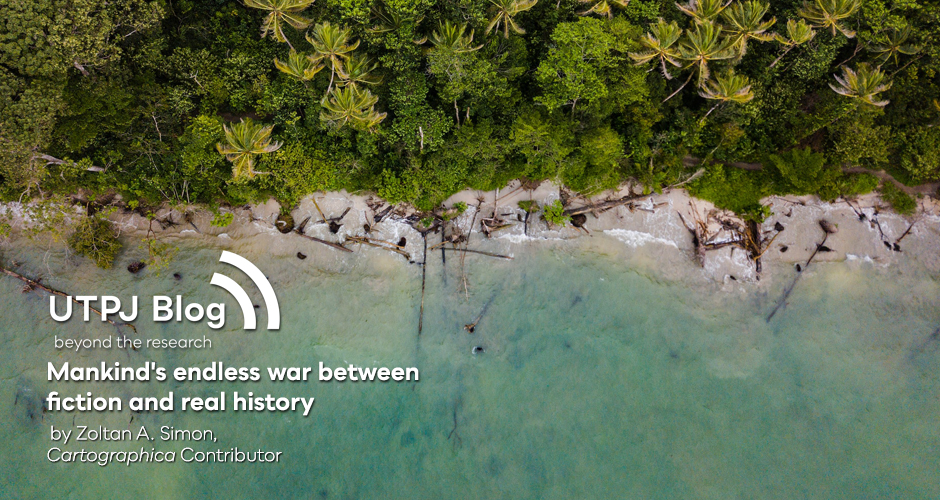
Written by guest blogger Zoltan A. Simon
My paper in the Cartographica journal (Volume 57, Issue 1 2022) is a summary of a forty-six-year long research on the historical Robinson Crusoe, his real island, and a true history in Costa Rica. Between the lines, it is challenging the scholarly consensus that assumes the identity of Crusoe with Alexander Selkirk within Daniel Defoe’s fictitious story.
In 1982, I was ready to visit the candidate island in Central America. The American firm organizing the expedition cancelled the trip because their insurance company did not find the vessel seaworthy. I was determined to escape the rainy Vancouver winter and took a flight, hoping at least to meet a Costa Rican woman. Being unable to find a match, one day I took a bus at the terminal in San José. A perfect happiness and peace on my face showed that as a free man, I didn’t care about women anymore. Then the driver stopped for two girls running after the bus. They sat next to me in the empty bus. My manly freedom lasted for five minutes. Soon I married the older girl, a Salvadorean refugee. Without that driver and Robinson Crusoe, I would not have a daughter, a son, and three nice grandsons now.
Thus, my efforts about identifying Crusoe’s desert island were successful on the family level. Four more decades passed with extensive research, in Canada’s many libraries, then online. My paper departs from the scholarly consensus based on the optical reasoning of Gildon, an embittered blind critic. Instead, it utilizes the arsenal of scientific evidence and arguments. If Defoe considered himself the editor, a real Robinson Kreutznaer must have existed as the author. Friday, originally a cannibal with his recorded native Térraba words, once lived in England. Their island has been identified as Cocos Island (Isla del Coco in Spanish) in the Pacific Ocean, mainly by topographical evidence. Crusoe determined the island’s latitude by instrument, reading it 9°22ʹ North, without applying any correction. Comparing it with Robert Louis Stevenson’s Treasure Island, the latter is a fictitious story of a professional writer. The only historical element in it is the map, a later chart of Cocos Island, that could not have been drawn by a child or children. Three red crosses indicate the locations of three treasures in it. Four decades ago, I would have found it insane to reveal their locations freely for the world as I did.
My other works are strictly scientific as well. The history of Herodotus and Homer’s Odyssey are comparable to Crusoe’s autobiography. In the Odyssey, “the sun has perished out of heaven and an evil mist hovers over all”, in the fourth year after the fall of Troy. It refers to a total eclipse at Ithaca. Herodotus described historical eclipses of Xerxes and Cleombrotus, 18 months apart, but modern scholars qualified both as “literary eclipses” of an unreliable teller of fables. A century ago, scholarly consensus qualified the Bible as religious literary fiction, without any useful material for historians and archeologists. The consensus accepted the book of Edwin Thiele, combined with an unspecified Assyrian solar eclipse record, assuming an unbroken list of eponyms. Then, thousands of scholars worked hard to reconstruct the “baby that had been thrown out with the bathwater.” Ancient Irish and Scottish historians carefully recorded the year of their departure from Egypt, right after the Exodus, reckoning their years from that event. My concern is that Crusoe, Homer, Herodotus, Diodorus Siculus, Ptolemy, and the Bible cannot be placed in a small “literary fiction” drawer next to the story of Snow White. Most Egyptologists sacrifice their lives through excavations and publications but overlook a problem: If an ivory tablet from the First Dynasty is considered, a “Menophres Era” calendar reform may have existed. In that case, most of their Egyptian dates are wrong.
“Is an eclipse described in the Odyssey?” This was a serious paper published in 2008. Four years later its authors were strongly criticized, showing that scientists are often unwelcomed guests in literary territory. This may be the fate of my Crusoe paper in Cartographica but so far there is silence, without any scientific reply. Silencing a dissenting conclusion is the best strategy for critics that are against the advancement of the sciences. After another three centuries of Sleeping Beauty dreams, the literature may remark briefly: “Zoltan A. Simon, a Canadian Hungarian, was a legendary person that has never existed. No real person with a reasonable mind could challenge a long list of established scholarly views.” In any case, I have fulfilled my obligations as humanly as possible towards universal readership and the memory of a real but forgotten author, Robinson Crusoe. My only message to him would be that he should not have obeyed Defoe’s suggestions to change some of the dates or places. A minor change, moving the events to the Orinoco River, was shifting his true story to the lands of fiction.
My general question to mankind remains: a concern that there is a major disconnect between modern humans and ancient authors, often preventing us from understanding real history and the past. Is the human race more willing to accept fiction and fake news than true facts?
Special thanks go to my two anonymous reviewers and copy editor William H. Stoddard. It is a privilege to belong to the team of Cartographica.
Zoltan Andrew Simon is a Canadian Hungarian born in 1949. He was originally a geologist and land surveyor with diplomas (Budapest and Székesfehérvár) and two decades of Canadian experience in civil engineering. His book Absolute Dates for Ancient China by Astronomy was published in 2007 by Rhombos-Verlag in Berlin. He lives in Red Deer and can be contacted by email at zasimon@hotmail.
“Robinson Crusoe’s Travels on Maps from Costa Rica to Russia” was published in Cartographica 57.1 and is Free to Read until January 12th.
Comments on this entry are closed.